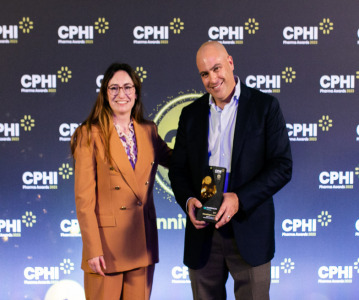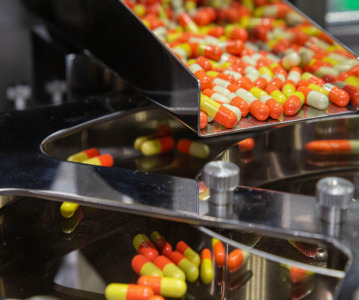Breaking Barriers: Innovations in Oral Solid Dose Form Bioavailability

The effectiveness of a medication often hinges on its bioavailability – the rate and extent at which the active ingredient is absorbed into the bloodstream. When it comes to oral solid dose forms, such as tablets and capsules, the challenge lies in achieving optimal bioavailability for drugs with varying solubilities.
This article explores the factors affecting drug bioavailability, strategies to enhance it, and innovative formulation approaches for poorly soluble drugs.
Factors Affecting Drug Bioavailability:
Drug bioavailability is influenced by a multitude of factors that span both the physiological and pharmaceutical realms. These include:
- Solubility: The fundamental property that dictates a drug's dissolution in bodily fluids. Poorly soluble drugs may struggle to dissolve quickly, limiting their absorption.
- Particle Size: Smaller particles have a larger surface area, enabling faster dissolution and absorption.
- pH Environment: Gastric and intestinal pH levels can impact a drug's solubility and stability.
- Food Interactions: Some drugs must be taken on an empty stomach for optimal absorption, while others require food to enhance bioavailability.
- First-Pass Metabolism: Enzymes in the liver can metabolize a drug before it reaches systemic circulation.
- Formulation Type: The dosage form – whether immediate-release, extended-release, or controlled-release – affects how the drug is released and absorbed.
- Physiological Variability: Factors such as genetics, age, and health status influence how an individual's body absorbs and processes drugs.
Improving Bioavailability:
To enhance the bioavailability of oral solid dose forms, pharmaceutical researchers and formulators have devised several strategies:
- Particle Size Reduction: By reducing the drug's particle size, the surface area available for dissolution increases, promoting faster absorption. Technologies like micronization and nanosizing have been employed to achieve this.
- Amorphous Solid Dispersions: Transforming a drug from its crystalline form to an amorphous state can improve its solubility, as amorphous materials tend to dissolve more readily.
- Cocrystals: These are structures where an active pharmaceutical ingredient forms a crystal lattice with another molecule, often a coformer. This can lead to improved solubility and stability.
- Lipid-Based Formulations: Incorporating drugs into lipid-based systems, such as self-emulsifying drug delivery systems (SEDDS) or solid lipid nanoparticles (SLNs), can enhance solubility and bioavailability.
- pH Modification: Adjusting the pH of the drug formulation or using pH-modifying excipients can impact solubility and dissolution, subsequently affecting bioavailability.
- Prodrug Design: Converting a drug into a more soluble and easily absorbed derivative can enhance bioavailability upon metabolic conversion in the body.
Formulation Strategies for Poorly Soluble Drugs:
Dealing with poorly soluble drugs is a common challenge in pharmaceutical development. Formulation strategies to tackle this issue include:
- Nanosuspensions: These are submicron colloidal dispersions of drug particles in an aqueous vehicle. They offer improved dissolution and potentially enhanced bioavailability.
- Solid Dispersion: Mixing a poorly soluble drug with a hydrophilic polymer or surfactant can create a solid dispersion that enhances dissolution and absorption.
- Lipid Formulations: Lipid-based drug delivery systems, such as micelles and liposomes, can solubilize lipophilic drugs, improving their bioavailability.
- Spray Drying: This technique involves converting a liquid drug formulation into solid particles through atomization. It can result in amorphous formulations that dissolve more readily.
- Nanocrystals: Similar to nanosuspensions, nanocrystals are pure drug particles with nanoscale dimensions, leading to enhanced solubility and bioavailability.
Breaking down barriers to enhance the bioavailability of drugs encapsulated in oral solid dose forms requires a deep understanding of the interplay between formulation science and physiological factors. Advances in particle engineering, amorphous solid dispersions, lipid-based systems, and innovative drug delivery approaches have paved the way for improving the absorption and efficacy of poorly soluble drugs.
As pharmaceutical researchers continue to push the boundaries of formulation technology, the future holds the promise of more effective treatments that maximise therapeutic outcomes through enhanced bioavailability.
Overcoming obstacles at CPHI Barcelona
Join us at CPHI Barcelona to find out how industry professionals are facing up to formulation challenges. Hear from – and meet – everyone from the big players to disruptive start-ups.
Your CPHI Barcelona pass gives you access to all conference sessions, including Formulating the Future, as well as the chance to connect in-person with the global pharma supply chain from 24-26 October, at Fira Barcelona Gran Via. Browse the agenda and secure your pass today!
Related News
-
News CPHI Pharma Awards 2023 – Sustainability winners: Schneider Electric
After another year of impressive nominations for the CPHI Pharma Awards our winners were announced at CPHI Barcelona in October 2023. In this series of interviews, we speak to the people and teams behind the award-winning projects, concepts, and techno... -
News CPHI Pharma Awards 2023 – At the Heart of Pharma winners: Merck KGaA
After another year of impressive nominations for the CPHI Pharma Awards our winners were announced at CPHI Barcelona in October 2023. In this series of interviews, we speak to the people and teams behind the award-winning projects, concepts, and techno... -
News CPHI Pharma Awards 2023 – Packaging & Machinery Winner: Gasporox
After another year of impressive nominations for the CPHI Pharma Awards our winners were announced at CPHI Barcelona in October 2023. In this series of interviews, we speak to the people and teams behind the award-winning projects, concepts, and techno... -
News CPHI Pharma Awards 2023 – CEO of the Year Winner: Enrico Zodio, PROCOS S.P.A.
After another year of impressive nominations for the CPHI Pharma Awards our winners were announced at CPHI Barcelona in October 2023. In this series of interviews, we speak to the people and teams behind the award-winning projects, concepts, technologi... -
News CPHI Pharma Awards 2023 – Supply Chain Excellence Winners: Catalent Case Management Services
After another year of impressive nominations for the CPHI Pharma Awards our winners were announced at CPHI Barcelona in October. In this series of interviews, we speak to the people and teams behind the award-winning projects, concepts, and technologie... -
News CPHI Pharma Awards 2023 – API Development and Innovation Winners: Snapdragon Chemistry, a Cambrex Company
After another year of impressive nominations for the CPHI Pharma Awards our winners were announced at CPHI Barcelona in October. In this series of interviews, we speak to the teams behind the award-winning projects, concepts, and technologies. -
News Navigating the Future: Challenges and Opportunities in Pharma Innovation and Investment – CPHI Barcelona 2023 Roundtable Report
In this comprehensive downloadable report, hear from a range of experts in finance and investment in the pharma industry on what investment trends will be shaping the future of the industry, in Catalonia, and the wider world. -
News CPHI Barcelona: Outsourcing in Manufacturing Operations
During CPHI Barcelona 2023, insightful content sessions offered attendees the chance to explore trending topics with expert speakers and panellists. Here, we summarise what the pharma industry and supply chain are talking about the most.
Recently Visited
Position your company at the heart of the global Pharma industry with a CPHI Online membership
-
Your products and solutions visible to thousands of visitors within the largest Pharma marketplace
-
Generate high-quality, engaged leads for your business, all year round
-
Promote your business as the industry’s thought-leader by hosting your reports, brochures and videos within your profile
-
Your company’s profile boosted at all participating CPHI events
-
An easy-to-use platform with a detailed dashboard showing your leads and performance


.png)




